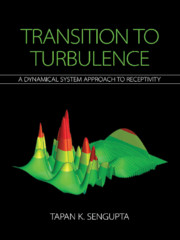Book contents
- Frontmatter
- Dedication
- Contents
- Preface
- 1 Receptivity, Instability, and Transition: A Perspective
- 2 Dynamical System Theory and Role of Equilibrium Flows
- 3 Fundamentals of Scientific Computing
- 4 Instability and Transition
- 5 Receptivity Analysis: Relation with Instability Experiments
- 6 Dynamical System Theory of Linear Receptivity
- 7 Nonlinear, Nonparallel Effects on Receptivity, Instability, and Transition
- 8 Three-Dimensional Routes of Transition to Turbulence
- 9 Receptivity to Free Stream Excitation: Theory, Computations, and Experiments
- 10 Nonlinear Receptivity Theories: Hopf Bifurcations and Proper Orthogonal Decomposition for Instability Studies
- 11 Mixed Convection Flow
- 12 Baroclinic Instability: Rayleigh–Taylor Instability
- 13 Coherent Structure Tracking in Transitional and Turbulent Flows
- 14 The Route of Transition to Turbulence: Solution of Global Nonlinear Navier–Stokes Equation
- References
1 - Receptivity, Instability, and Transition: A Perspective
Published online by Cambridge University Press: 16 February 2021
- Frontmatter
- Dedication
- Contents
- Preface
- 1 Receptivity, Instability, and Transition: A Perspective
- 2 Dynamical System Theory and Role of Equilibrium Flows
- 3 Fundamentals of Scientific Computing
- 4 Instability and Transition
- 5 Receptivity Analysis: Relation with Instability Experiments
- 6 Dynamical System Theory of Linear Receptivity
- 7 Nonlinear, Nonparallel Effects on Receptivity, Instability, and Transition
- 8 Three-Dimensional Routes of Transition to Turbulence
- 9 Receptivity to Free Stream Excitation: Theory, Computations, and Experiments
- 10 Nonlinear Receptivity Theories: Hopf Bifurcations and Proper Orthogonal Decomposition for Instability Studies
- 11 Mixed Convection Flow
- 12 Baroclinic Instability: Rayleigh–Taylor Instability
- 13 Coherent Structure Tracking in Transitional and Turbulent Flows
- 14 The Route of Transition to Turbulence: Solution of Global Nonlinear Navier–Stokes Equation
- References
Summary
Historical Introduction
In many natural or engineering fluid flows, turbulence is the natural state. However, in the eighteenth century, when fluid dynamicists were divided into two distinct and separate schools of thought belonging to hydrodynamics and hydraulics, they did not have the benefit of the Navier–Stokes equation (NSE, not developed at that time) that governs all incompressible fluid flow behavior. The hydrodynamics practitioners did not envisage the importance of viscous flow, as it was thought to be confined to a very narrow region near the body placed in a flowing fluid, while most of the flow region was considered to be inviscid. This was the justification for the use of Euler's equation. Hydraulics practitioners approached their problems with charts and tables obtained empirically from actual observations. This segregation of thought continued for another century until the advent of the boundary layer theory, proposed by Prandtl [338], which we will visit later in the book.
After the derivation of the viscous flow equations [311, 501] by introducing the constitutive relation between the stress and rate of strain to obtain the Navier–Stokes equation [20, 412], Stokes tested the equations using pipe flow experiments. There was absolutely no match between the “exact” solution of the Navier–Stokes equation and the experimental observations. There could have been various reasons for this: for example, the analytical solution of the Navier–Stokes equation is obtained after many simplifying assumptions; moreover, the correctness of the constitutive relation and no-slip condition has not been rigorously established even today, and so what is an “exact” solution? We will revisit the constitutive relation between the stress and rate of strain while discussing the Rayleigh–Taylor instability problem.
It is pertinent to note that, in the absence of rigorous proof, even today, the no-slip condition is considered as a modeling approximation. Although Batchelor [20] noted that for Newtonian fluid flow, the absence of slip at a rigid wall is now amply confirmed by direct observation and by the correctness of its many consequences under normal conditions. In microfluidics, continuum equations are often solved with slip boundary conditions, while solving the Navier–Stokes equation [217].
Introduction to ow instability
In retrospective, one can observe now that the analytical solution obtained by Stokes for pipe flow was acutally for a laminar flow, while the real flow was turbulent for the operating conditions.
- Type
- Chapter
- Information
- Transition to TurbulenceA Dynamical System Approach to Receptivity, pp. 1 - 29Publisher: Cambridge University PressPrint publication year: 2021



